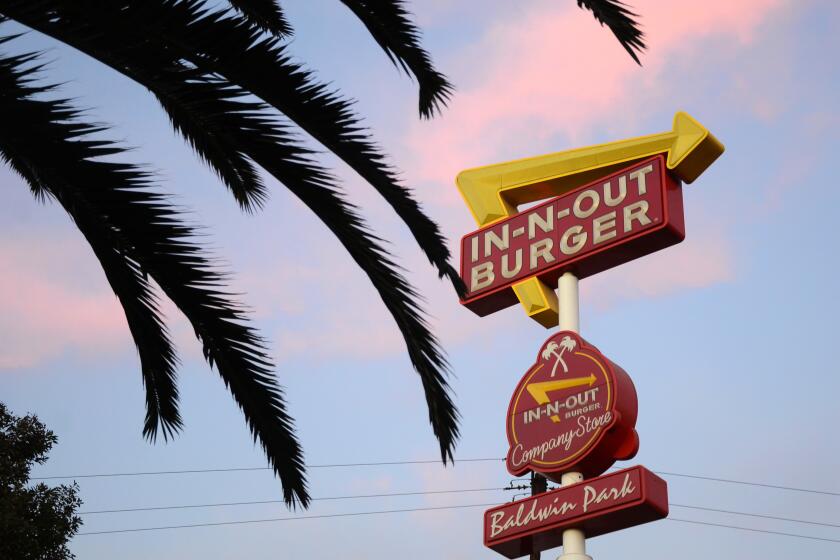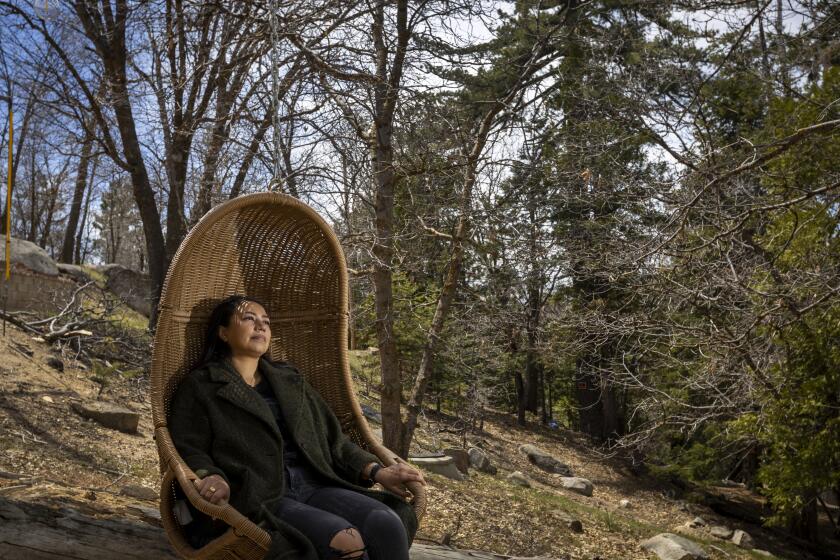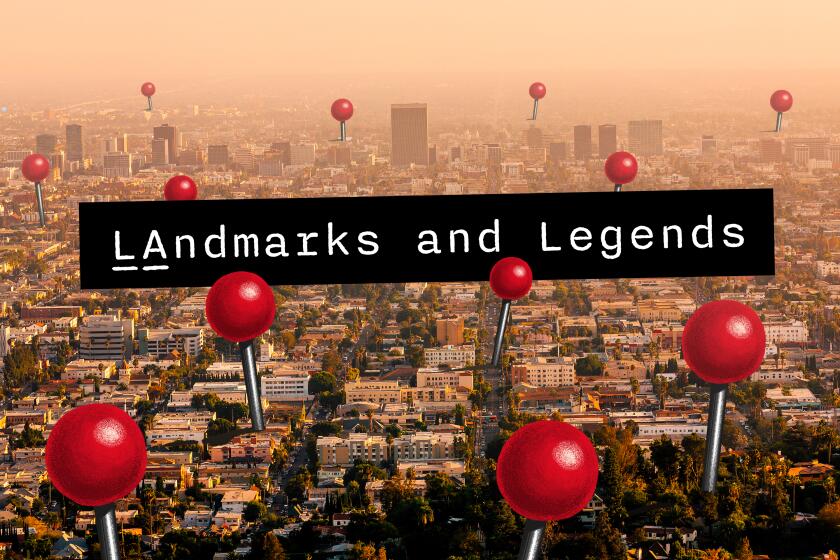Griffith Park is named for a guy who shot his wife — and other true stories of L.A. parks
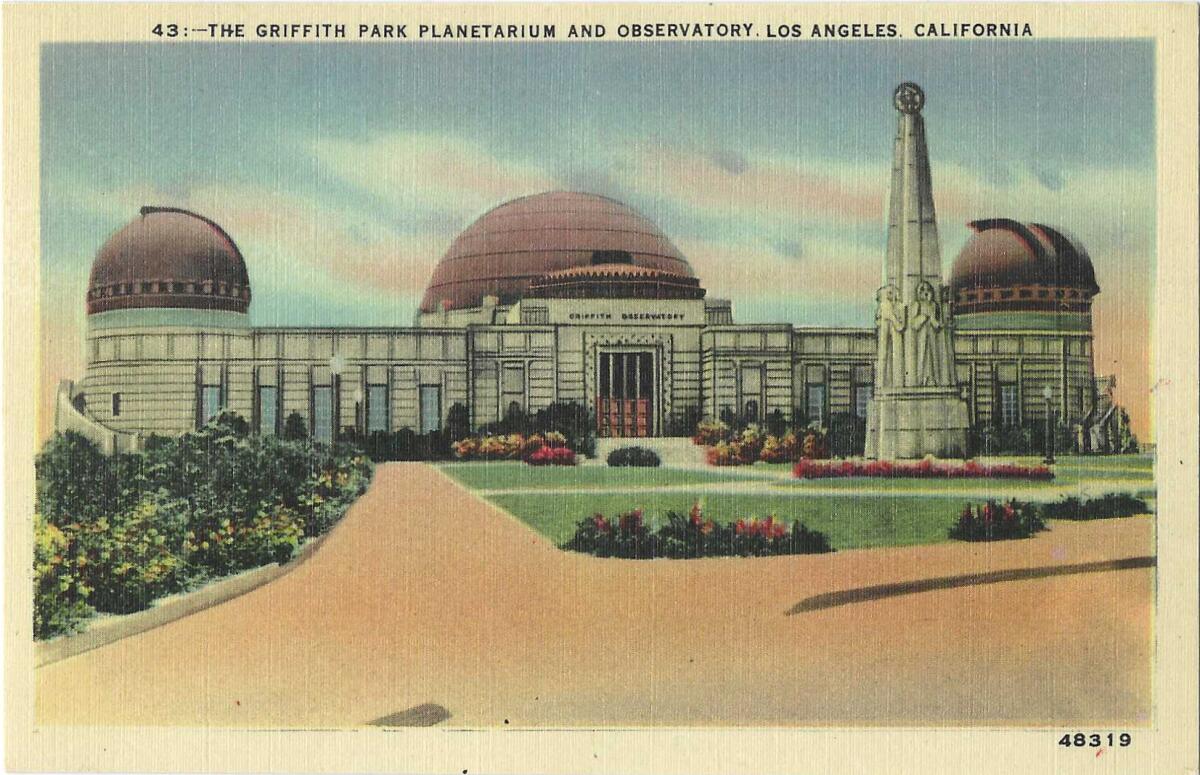
Picnic basket — check. Sunscreen — check. Trashy novel — check.
Now, where to park yourself for a summer day at the park?
Well, there’s Ernest’s or Griffith’s place. Or Seily’s, or Virginia’s. There’s Jack’s in Long Beach, or Jackie’s in Pasadena.
We don’t often wonder about the names of the places where we disport ourselves. But how did some parks get named for some people? The heroes and pioneers you know already. Throughout the city and county of Los Angeles, parks are named for Jesse Owens and Cesar Chavez, George Washington Carver and Ritchie Valens, Mary McLeod Bethune and Jackie Robinson, along with dimly recalled politicians and developers.
Let’s take a skip around some of Los Angeles’ city and county parks, shall we?
For Subscribers
Who are the people behind the L.A. places you know and love?
Griffith Park
Begin with the biggest. If not for Griffith Park’s 4,200-plus acres, L.A.’s ranking among cities’ parklands would be far more dismal than it is already. It was not, as some believe, named for D.W. Griffith, the silent film director who created much of the vocabulary of film, as well as the often-offensive “Birth of a Nation.”
No. It was named for the man who gave it to L.A., the Welsh immigrant and mining magnate Col. Griffith Jenkins Griffith. Griffith was one of those self-mythologizing frontier characters, a self-promoter of choleric temper and roller-coaster fortunes; the “colonel” title itself is of murky origin, perhaps from some brief spell with the California National Guard. An acquaintance called him “a midget egomaniac.”
In the 1880s he bought up Rancho Los Feliz land with an eye to profits, but there were no buyers; the rumor of a curse still clung to the land.
So at Christmas 1896 he presented the city with thousands of acres, along with the pious sentiment that would wind up on his statue in Griffith Park: “Public parks are a safety valve of great cities . . . and should be accessible and attractive, where neither race, creed nor color should be excluded.” The pioneer and publisher Horace Bell, who loved to deflate Griffith’s pomposity in print, made it clear he thought the gift was merely a tax dodge. Still, the city took it.
But in 1903, Griffith badly blotted his copybook. He and his wife, Christina, a landowning, Catholic descendant of the founding Verdugo family, were staying in the presidential suite at the Bandini Hotel in Santa Monica when the very sozzled Griffith, in a fury of what the sentencing judge would call “revolting, gross, unmanly and degrading” behavior, burst in on his wife, held a gun to her head, and accused her of mad things like being in league with the Pope to poison him.
As Mrs. G begged on her knees for her life, Griffith fired. Mrs. G fortuitously flinched, and the bullet went through an eye instead of her brain. She leaped from the window but lived to tell the story a year later in divorce court, her blind eye and scarred face concealed behind a veil. It may have been the original quickie divorce: It took four and a half minutes. Her ex — still in the hoosegow in Los Angeles — was tried and sentenced to a two-year stretch at San Quentin.
Once he was out of prison, Griffith sought to buy his way back into civic favor with the gift of money to build a planetarium and Greek theater. The city balked. Not until Griffith’s will made the gift posthumously was it accepted.
About 10 million people go to the park each year. So too do filmmakers who agree with long-ago silent film producer Abe Stern’s advice to directors longing to make their movies in distant and costly locations: “A rock is a rock. A tree is a tree. Shoot it in Griffith Park.”
It’s just about Lummis Day. But who, or what, is a Lummis? Well, both — Lummis was a person and is the name of a house. In L.A., you may not know the names behind many landmark buildings. So here are a few important ones.
Maggie Hathaway Golf Course
Now, in Jesse Owens Community Regional Park, a county park in the 9000 block of South Western Avenue, there’s a nine-hole golf course that bears the name of Maggie Hathaway.
In one of her life’s incarnations, Hathaway was a stand-in for Lena Horne in “Stormy Weather,” and — so says IMDb — she cut quite a rug onscreen as a jitterbugging maid in a musical short, and as a dancer in the Marx Brothers’ comedy “At the Circus,” and in “Cabin in the Sky.”
But her name is on the golf course because she held the very white game of golf to account. She took her first swing at a golf ball in 1955 on the Griffith Park course, where she had gone to give Black boxing champ Joe Louis a piece of her mind for playing in a pro-am tournament when “truly excellent Black golfers” were barred from pro golf.
She found him on the eighth hole, and as he hit the ball onto the green, she scoffed, “Anybody could do that.” Louis bet Hathaway a set of golf clubs that she couldn’t. She did — her first-ever golf swing — and battled for Black golfing ever after.
Using donated and cut-down clubs, she taught kids to golf, and wrote a golf column for the Los Angeles Sentinel. Covering the 1971 Masters tournament, she fainted dead away when Black golfer Lee Elder broke the color barrier at the first tee. The woman had style and she had moxie, and deserves a full 18 holes to be someday named for her too.
Eugene A. Obregón Park
The name of a teenaged war hero from East L.A. appears on several memorials around L.A., and on a park close to home. Marine PFC Eugene A. Obregón was awarded the Medal of Honor posthumously for his actions in Seoul, Korea, in September 1950.
Obregon saw his buddy, a Texas kid named Bert Johnson, get hit. “Hang on, Bert, I’m coming to get you!” he hollered. Obregon dragged Johnson into a ditch with one hand and fired at the approaching North Korean platoon with the other. As the enemy closed in, Obregon emptied his pistol while shielding Johnson. He picked up Johnson’s carbine and fired until that too was empty. “Bert,” he told his friend, “if we’re going down, we’ll go down fighting like Marines.” Obregon yanked a grenade from his belt and threw it into the knot of North Korean soldiers, just as he was hit with machine gun fire.
Nineteen years after Obregon’s death, the seven-acre park was where Chicano moratorium marchers gathered at the end of their demonstration against the inequities of the Vietnam War.
Other parks, too, are named for those who died young. The Eastside Eddie Heredia Boxing Club is a county facility memorializing a promising 17-year-old boxer who died of leukemia. Seily Rodriguez Park in Hollywood was renamed for an 8-year-old girl killed by a car in 2005 as she walked to school. And in North Hollywood, the first city park created with privately raised money was built in memory of Jaime Beth Slavin, a 16-year-old Woodland Hills girl who died in 1983 of Reye’s syndrome.
Explaining L.A. With Patt Morrison
Los Angeles is a complex place. In this weekly feature, Patt Morrison is explaining how it works, its history and its culture.
Virginia Robinson Gardens
The county park that made the neighbors go “Eek!” was the gift of a woman who moved to Beverly Hills before it was, you know, Beverly Hills. Harry Robinson was heir to the department store fortune. Beginning in about 1912, he and his wife, Virginia, turned six acres that had been grazed bald by sheep into a kind of botanical zoo for their collection of exotics, tropicals and palms. He was expert in ferns, and she in roses.
Virginia Robinson left the place to L.A. County in 1974 for an arboretum, and visits are limited to 100 people a day. From the get-go, Beverly Hills regarded the gardens’ public status “with some apprehension,” as the city manager said.
When the county last year proposed doubling the visitor limit and opening the gardens to events like weddings, one City Council member suggested that the city might respond by limiting street parking all the way around the estate.
McDonald’s, In-N-Out, Carl’s Jr., Taco Bell, Del Taco, Der Wienerschnitzel ... you name the fast-food joint, it probably started here.
Runyon Canyon Park
To the east lies the city park of Runyon Canyon, where the beautiful people get more beautiful by dint of strenuous hiking and dog-walking. Runyon Canyon rises steeply from Franklin Avenue to Mulholland Drive. Its name comes from the 20th century, but its story began long before that, when the Tongva people camped and hunted there.
The precise geography is hazy, but in the 1860s, the government deeded about 160 acres, likely including Runyon Canyon, to the man known to history as “Greek George.” George Caralambo had helped the Army wrangle camels in a comically ill-starred try at adapting camels to military uses. Thereafter, Caralambo wandered east, through San Bernardino, where he shot a man who cheered when Caralambo’s horse lost a race, and thence to New Mexico, where he killed the governor’s son, and faked his own suicide.
He came back to L.A. and in 1867 took possession of his new acreage.
Detour to Vasquez Rocks
On said acreage, Caralambo welcomed a guest: Tiburcio Vasquez, the swashbuckling bandit chief who defended his crimes as a simple justice for his people against the Yankee invaders. Vasquez’s girlfriend, it seems, was also the sister of Caralambo’s wife. And it was at Greek George’s house that Vasquez was captured, in 1874, and sent to San Jose, where he was convicted and hanged, behaving, the papers marveled, “more like a gentleman than a knave.”
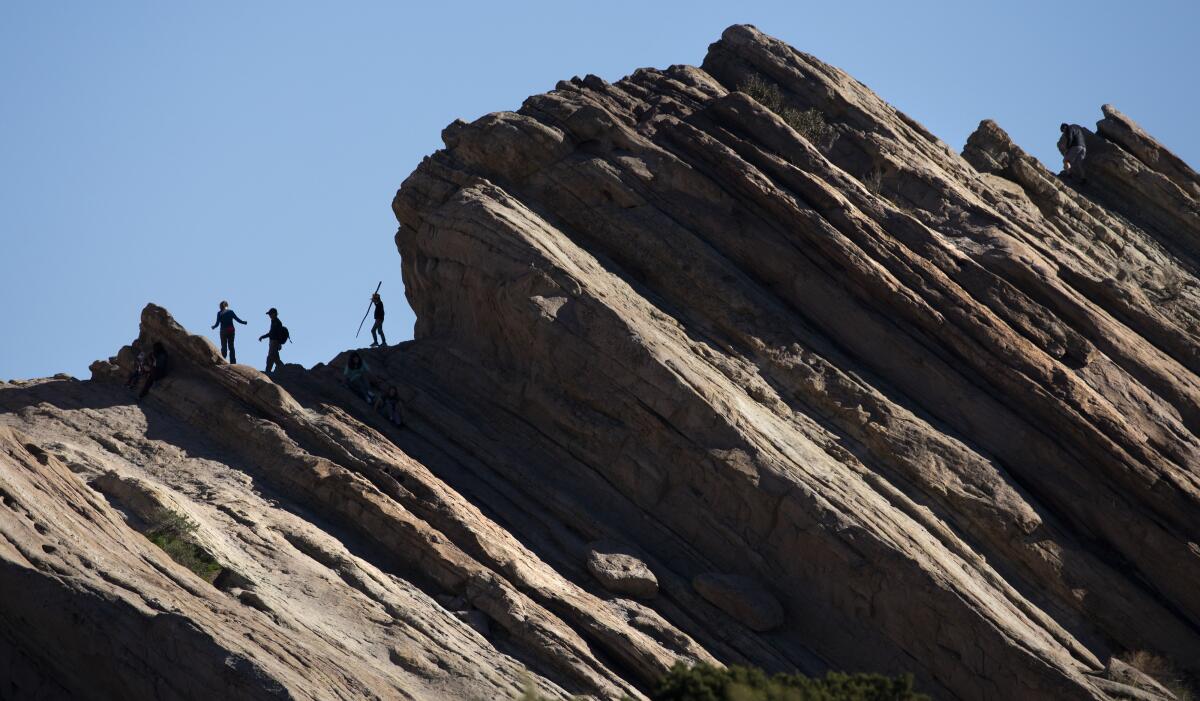
Vasquez has his own namesake park, the spectacular Vasquez Rocks, his onetime hideout — hundreds of acres with fabled, other-worldly sandstone formations in Agua Dulce. It was already a tourist attraction a hundred years ago, and Hollywood was not far behind. Vasquez Rocks played “strange new worlds” so often on “Star Trek” that the park should get residuals. In the 1950s, a film crew using the rocks as a stand-in for Red Rock Canyon in Nevada painted them red for vermilion verisimilitude. The red eventually faded to pink and back to tan, but ever since, the county has policed movie crews, and fined and banished those that alter so much as a pebble.
Back to Runyon Canyon
The 20th century would be hard-pressed to match the Greek George story, but it tried. The canyon was bought in 1919 by coal millionaire Carman Runyon. His second wife was Winifred Kingston, the widow of Dustin Farnum. That name doesn’t resonate today, but Farnum was the star of “The Squaw Man,” the film Cecil B. DeMille made when he set up shop on the flats of Hollywood.
An Irish tenor named John McCormack bought the land in 1929. When McCormack was on tour, his estate became a high-end AirBNB for movie folk like Marie Dressler and Charles Boyer. In later years, Errol Flynn moved into the estate’s poolhouse at the invitation of his host and the next owner, Huntington Hartford, heir to grocery store millions.
In the 1960s, Hartford offered the land as a flat-out gift to the city, but for some reason, Mayor Sam Yorty turned him down. In 1984, the city was finally able to buy the land. Somehow, of all of the landowners, it was the name “Runyon” that stuck.
This Mother’s Day, give moms the best gift of all: your time. Here are the best things to do on Mother’s Day in Los Angeles that aren’t brunch.
Ernest E. Debs Regional Park
When I first heard someone mention “Debs Park,” I imagined that in some wild, giddy moment, county officials had kicked over the traces and named the park after Eugene V. Debs, a passionate labor leader and five-time Socialist candidate for president who was sent to prison for speaking out against the U.S. taking part in World War I.
Alas, no. Ernest E. Debs Regional Park is the steep hillsides along the east side of the Arroyo Seco. After World War II, the land was selected for a big federal public housing project. Then someone compared the government plans to the topography, and saw that the neat grid layout was impossible in the actual pitch-and-drop hillsides known in one part as Monterey Hills and the other as Rose Hill.
So in a complex series of deals, the city got the land from the feds. In the meantime, Walter O’Malley, who moved the Dodgers to L.A., bought up privately owned land between Rose Hill and the Arroyo Seco, and swapped it with the city for acreage in Elysian Park, where he would build Dodger Stadium.
The neighbors, led by a former Sierra Club president called Nathan Clark, had kept developers at bay, and by the late 1960s, county Supervisor Ernest E. Debs managed to get the land dedicated for a county park. In 1974, as he retired, his colleagues voted unanimously to name the park for him.
The place’s creepiest moment? The night of Sept. 8, 1924.
Some schism was breaking up the state’s Ku Klux Klan, a not inconsiderable force in the 1920s, even here, and members were split over — well, who knows? Maybe how pointy the hoods should be.
Anyway, under a gibbous moon, almost 200 members of the women’s auxiliary, the “Kluxerettes” — cute, eh? — gathered in a circle at the Montecito summit and buried the constitution and bylaws of the parent klan. About 150 klansmen, likewise robed and hooded, stood there to support them. The neighbors, alarmed by a car convoy of people swaddled in bed linens, twice called the cops, but as The Times told it, “the officers left after learning that nothing more than a klan meeting was in progress.” Nothing to see here, move along.
Carlin G. Smith Recreation Center
Across the arroyo, in Mt. Washington, a ravine park is named for 1920s subdivider Carlin G. Smith. He ran for mayor in 1929, but he got bigger headlines when he sued the publisher of a political weekly for libel. The man had called Smith’s “baby milk fund” charity a “racket.” Smith lost the case. Curiously, he’d created a “Carlin G. Smith Community and Recreation Center Corporation” and when he donated the land to the city, voila, it came to pass.
Pershing Square
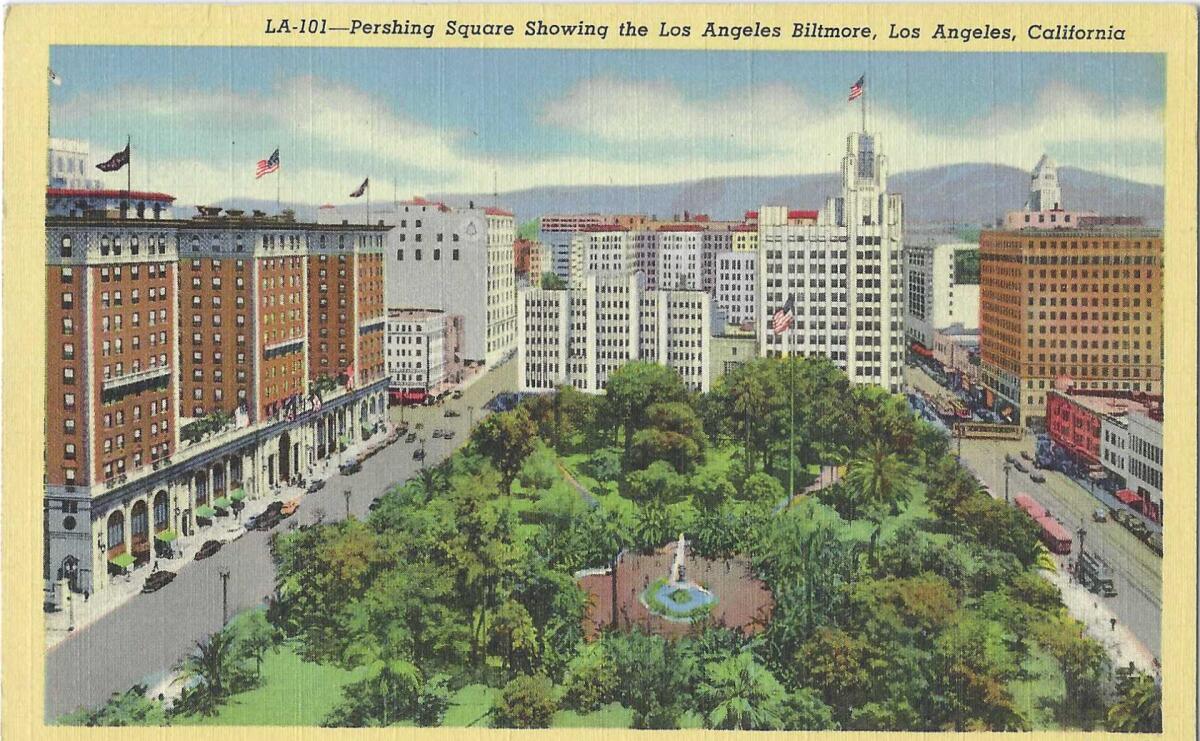
Now we turn to the dismal tale of Pershing Square. These five acres have been a city park since 1866, and over the decades, the park has shed its different names like a slow-mo stripper: St. Vincent’s Park, 6th Street Park, Los Angeles Park, Central Park.
“Pershing” is General John J. “Black Jack” Pershing, who pursued Pancho Villa’s forces along the U.S.-Mexico border a few years before going on to the “big show,” World War I. He led the American Expeditionary Forces on Europe’s Western Front in 1917 and 1918. In a patriotic mood, the city renamed the park for him in November 1918, one week after the armistice ended the war.
The park’s finest hours were in the 1920s, ‘30s and ‘40s, when its lush tropical foliage and prosaic rosebushes invited downtown workers to lunch al fresco. In the 1930s, the public library set out books on tables for borrow-and-bring-back midday reading. The most popular topics — sociology, economics, and religion — may have been research material for the haranguers and bloviators who took to the park’s “speakers’ corner” to spiel at the passing audiences.
The park once designated women-only benches to protect ladies from mashers. Then some of those ladies complained about being harassed by pesky real estate saleswomen.
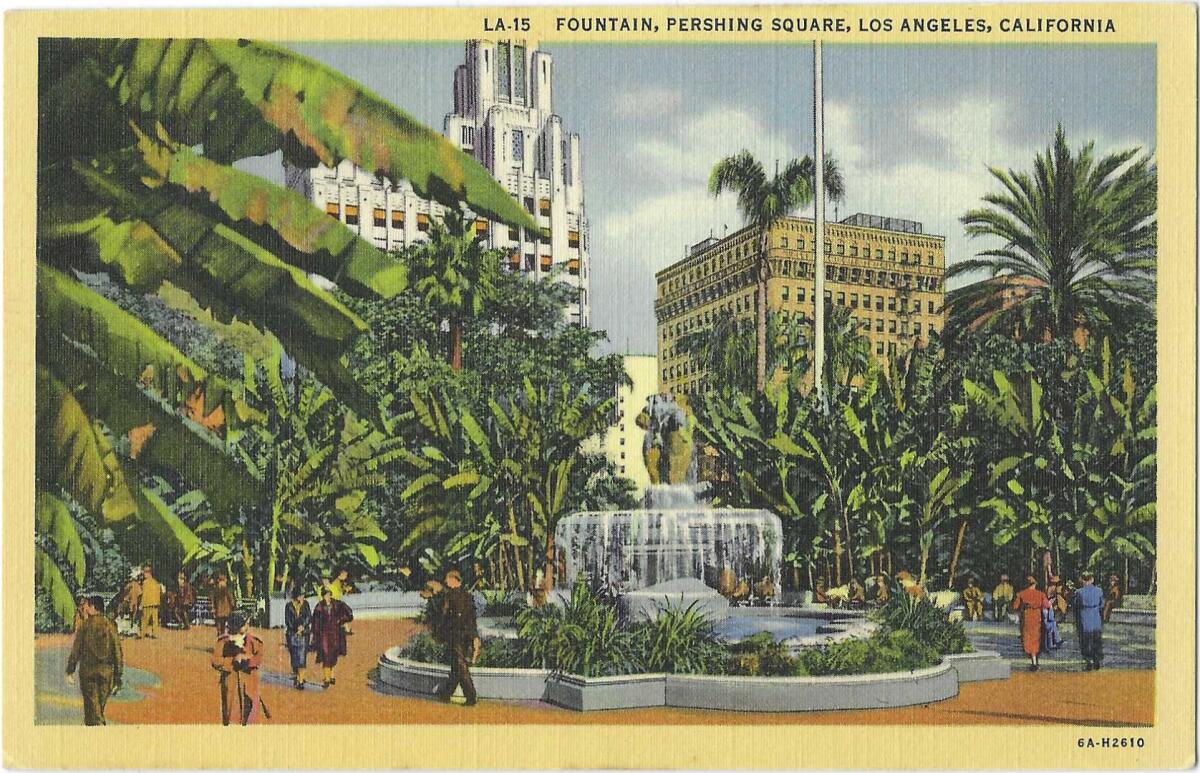
After World War II, the greenery was shaved to the roots to unseat the rats who hid out there, and as part of a vice campaign against naughty trysting.
In the early 1950s, the city added “-ing” to “park” and controversially dug out a subterranean garage below the park. It made the park feel elevated and isolated from the life of the street. Through a series of makeovers, designers have had to take into account the homeless people who occupy its acreage too.
The website Curbed Los Angeles once asked, “Do we dislike Pershing Square because it’s ugly, or is Pershing Square ugly because we dislike it?” I don’t know, but maybe we can give it another new name, one that at least includes the word “park.”
Amelia Mayberry Park
A little nosing around turns up a great number of parks named for politicians and developers, but once in a while, civic sentiment prevails. Whittier’s Amelia Mayberry Park was named for the librarian-newswoman-PTA leader who made free lunches for local schoolkids, and when that got to be too big a task, persuaded L.A. to open one of the state’s first school cafeterias.
Riverside and San Bernardino counties saw population gains as California overall lost nearly 262,000 residents between July 2020 and July 2021.
Jack Dunster Marine Biological Reserve
In Long Beach, the Jack Dunster Marine Biological Reserve honors the work of the local man who cobbled together a working expertise in engineering technology and marine life to create a flourishing ecosystem on the Los Cerritos Channel.
Bette Davis Picnic Area
My favorite, because the name makes me laugh, is the Bette Davis Picnic Area, along the Los Angeles River. Yes, Bette Davis worked nearby, at Warner Brothers; yes, she lived not far away and rode her horse along the bridle paths; and yes, she’s buried up the hill in Forest Lawn. But the dissonance of “Bette Davis” and “picnic”? A more urban actress I can’t conjure.
Davis is all mink stoles and martinis. Even in “Dark Victory,” in the scene where she’s outdoors, gardening as she knows she’s dying, she stabs her trowel at the flower bed like she’s eviscerating a treacherous lover. No, indeed. Bette Davis is no picnic.
Who is Griffith Park named for? What about Vasquez Rocks? The Broad? Mt. Baldy? Here are the namesakes of L.A.’s best-known landmarks.
More to Read
Sign up for Essential California
The most important California stories and recommendations in your inbox every morning.
You may occasionally receive promotional content from the Los Angeles Times.



